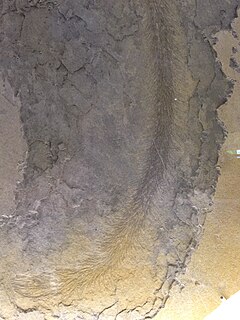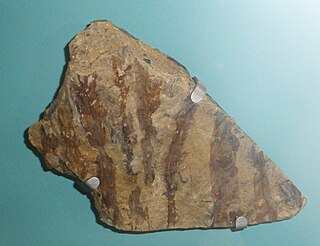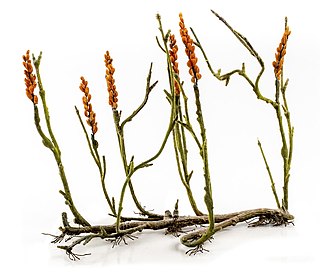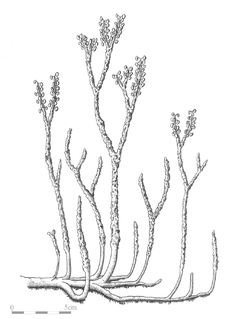
The lycophytes, when broadly circumscribed, are a vascular plant (tracheophyte) subgroup of the kingdom Plantae. They are sometimes placed in a division Lycopodiophyta or Lycophyta or in a subdivision Lycopodiophytina. They are one of the oldest lineages of extant (living) vascular plants; the group contains extinct plants that have been dated from the Silurian. Lycophytes were some of the dominating plant species of the Carboniferous period, and included tree-like species, although extant lycophytes are relatively small plants.

The zosterophylls are a group of extinct land plants that first appeared in the Silurian period. The taxon was first established by Banks in 1968 as the subdivision Zosterophyllophytina; they have since also been treated as the division Zosterophyllophyta or Zosterophyta and the class or plesion Zosterophyllopsida or Zosteropsida. They were among the first vascular plants in the fossil record, and had a world-wide distribution. They were probably stem-group lycophytes, forming a sister group to the ancestors of the living lycophytes. By the late Silurian a diverse assemblage of species existed, examples of which have been found fossilised in what is now Bathurst Island in Arctic Canada.

Baragwanathia is a genus of extinct lycopsid plants of Late Silurian to Early Devonian age, fossils of which have been found in Australia, Canada, China and Czechia. The name derives from William Baragwanath who discovered the first specimens of the type species, Baragwanathia longifolia, at Thomson River.

Drepanophycus is a genus of extinct plants of the division Lycopodiophyta of Early to Late Devonian age, found in Eastern Canada and Northeast US, China, Russia, Egypt and various parts of Northern Europe and Britain.

Asteroxylon is an extinct genus of vascular plants of the Division Lycopodiophyta known from anatomically preserved specimens described from the famous Early Devonian Rhynie chert and Windyfield chert in Aberdeenshire, Scotland. Asteroxylon is considered the most basal member of the Lycopsida.
Drepanophycaceae is a family of extinct lycophytes of Late Silurian to Late Devonian age, found in North America, China, Russia, Europe, and Australia.

Drepanophycales is an order of extinct lycopsid plants of Late Silurian to Late Devonian age, found in North America, China, Russia, Europe, and Australia. Sometimes known as the Asteroxylales or Baragwanathiales.

Psilophyton is a genus of extinct vascular plants. Described in 1859, it was one of the first fossil plants to be found which was of Devonian age. Specimens have been found in northern Maine, USA; Gaspé Bay, Quebec and New Brunswick, Canada; the Czech Republic; and Yunnan, China. Plants lacked leaves or true roots; spore-forming organs or sporangia were borne on the ends of branched clusters. It is significantly more complex than some other plants of comparable age and is thought to be part of the group from within which the modern ferns and seed plants evolved.

Leclercqia is a genus of early ligulate lycopsids (clubmosses), known as fossils from the Middle Devonian of Australia, North America, Germany, and Belgium. It has been placed in the Protolepidodendrales.

Zosterophyllum was a genus of Silurian-Devonian vascular land plants with naked branching axes on which usually kidney-shaped sporangia were arranged in lateral positions. It is the type genus for the group known as zosterophylls, thought to be part of the lineage from which modern lycophytes evolved. More than 20 species have been described.

Polysporangiophytes, also called polysporangiates or formally Polysporangiophyta, are plants in which the spore-bearing generation (sporophyte) has branching stems (axes) that bear sporangia. The name literally means 'many sporangia plant'. The clade includes all land plants (embryophytes) except for the bryophytes whose sporophytes are normally unbranched, even if a few exceptional cases occur. While the definition is independent of the presence of vascular tissue, all living polysporangiophytes also have vascular tissue, i.e., are vascular plants or tracheophytes. Extinct polysporangiophytes are known that have no vascular tissue and so are not tracheophytes.

The Sawdoniales are an order or plesion of extinct zosterophylls. The zosterophylls were among the first vascular plants in the fossil record, and share an ancestor with the living lycophytes. The group has been divided up in various ways. In their major cladistic study of early land plants, Kenrick and Crane placed most of the zosterophylls in the Sawdoniales.

Renalia is a genus of extinct vascular plants from the Early Devonian. It was first described in 1976 from compressed fossils in the Battery Point Formation. It is difficult to reconstruct the original form of the complete plant, but it appears to have consisted of leafless branching stems whose side branches had sporangia at their tips. It is regarded as an early relative of the lycophytes.

Adoketophyton is a genus of extinct vascular plants of the Early Devonian. The plant was first described in 1977 based on fossil specimens from the Posongchong Formation, Wenshan district, Yunnan, China. These were originally named Zosterophyllum subverticillatum; later the species was transferred to a new genus as Adoketophyton subverticillatum. One cladistic analysis suggested that it is a lycophyte, related to the zosterophylls. Other researchers regard its placement within the vascular plants as uncertain.
Discalis is a genus of extinct vascular plants of the Early Devonian. The name is derived from the Greek δίσκος, referring to the disc-shaped sporangia. The genus was first described by Hao in 1989 based on fossil specimens from the Posongchong Formation, Wenshan district, Yunnan, China.
Distichophytum is a genus of extinct vascular plants of the Late Silurian (Ludfordian) to Early Devonian (Emsian), around 426 to 393 million years ago. The genus has a tangled taxonomic history, also being known as Bucheria and Rebuchia.

Nothia was a genus of Early Devonian vascular plants whose fossils were found in the Rhynie chert in Scotland. It had branching horizontal underground stems (rhizomes) and leafless aerial stems (axes) bearing lateral and terminal spore-forming organs (sporangia). Its aerial stems were covered with small 'bumps' (emergences), each bearing a stoma. It is one of the best described early land plants. Its classification remains uncertain, although it has been treated as a zosterophyll. There is one species, N. aphylla.

Ventarura is a genus of extinct vascular plants of the Early Devonian. Fossils were found in the Windyfield chert, Rhynie, Scotland. Some features, such as bivalved sporangia borne laterally and the anatomy of the xylem, relate this genus to the zosterophylls. Other features are unclear due to poor preservation.
Trichopherophyton is a genus of extinct vascular plants of the Early Devonian. Fossils were found in the Rhynie chert, Scotland. The remains are very fragmentary, but the plant appears to be related to the zosterophylls.
Demersatheca is a genus of extinct vascular plants of the Early Devonian. Fossils were first found in the Posongchong Formation of eastern Yunnan, China. The plant had smooth leafless stems at least 1 mm in diameter, but only regions which bore spore-forming organs or sporangia are well-known. Sporangia were borne in 'spikes' or strobili, at least 40 mm long; one had 32 sporangia. Sporangia were arranged in four rows, two sporangia being opposite to one another on the stem with the next two being at right angles. Each sporangium consisted of two 'valves' which opened at the top to release their spores. A particular feature of Demersatheca which distinguishes it from other zosterophylls is that the stalk-less sporangia were sunken into the stem of the spike, so that the outer valve was flush with the surface.















